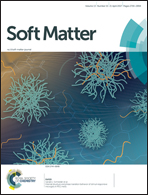Phase behavior of colloid–polymer depletion mixtures with unary or binary depletants†
Abstract
Adding depletants to a colloidal suspension induces an attractive interparticle interaction that can be tuned to obtain desired structures or to probe phase behavior. When the depletant is not uniform in size, however, both the range and strength of the attraction become difficult to predict and hence control. We investigated the effects of depletant bidispersity on the non-equilibrium phase behavior of colloid–polymer mixtures. We added unary or binary mixtures of polystyrene as the depletant to suspensions of charged poly(methyl methacrylate) particles. The structure and dynamics of the particles were compared over three sets of samples with various mixtures of two different polystyrenes whose size varied by an order of magnitude. The structure and dynamics were nearly independent of depletant dispersity if the polymer concentration was represented as a sum of normalized concentrations of each species. Near the transition region between a fluid of clusters and an interconnected gel at intermediate volume fractions, partitioning of polymers in a binary mixture into colloid-rich and polymer-rich phase leads to a slightly different gelation pathway.



 Please wait while we load your content...
Please wait while we load your content...